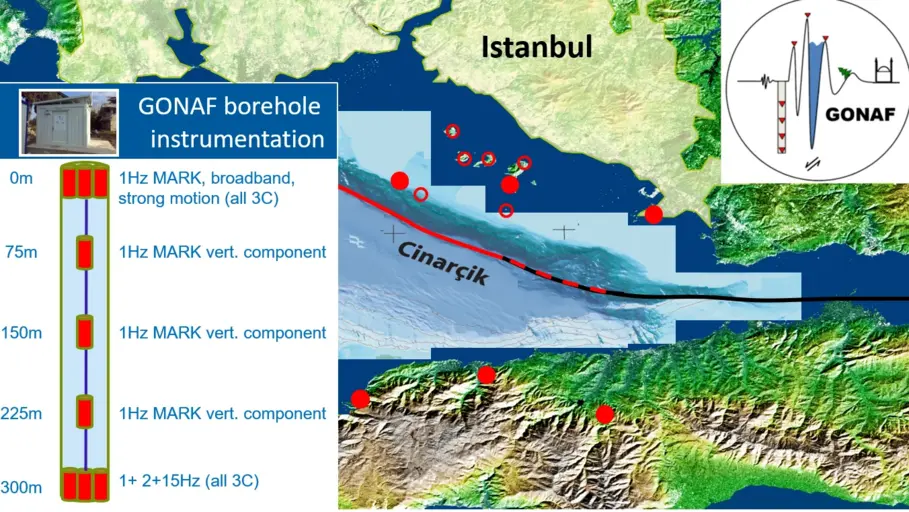GONAF - Geophysical Observatory at The North Anatolian Fault
Contact:
Web:
Infrastructure belongs to:
GONAF (Geophysical Observatory at the North Anatolian Fault) is a combined surface and downhole based observatory to measure tectonic deformation transients (seismic and aseismic) along the overdue Marmara segment of the North Anatolian Fault Zone (NAFZ) in northwestern Türkiye. There, a M>7 earthquake is pending in direct vicinity to the Istanbul megapolis.
The main objectives of the GONAF observatory are:
- to identify potentially creeping and locked fault segments (asperities) - the latter representing a high potential for a large rupture with subsequent directivity effects and ground shaking
- monitoring of deformation transients that could point towards the occurrence of a hazardous event.
The fact that the entire Marmara section of the NAFZ is under water makes high-resolution seismic and geodetic monitoring of seismicity, slow-slip events and potential creep a challenging task. The GONAF borehole-based geophysical instrumentation surrounding the eastern Sea of Marmara region was conceived and developed in the context of the International Continental Drilling Program (ICDP). Since 2015 GONAF has equipped 11 boreholes at 7 locations with borehole geophones and strainmeters, ensuring a high-resolution real-time monitoring of the Marmara seismic gap. Combining the data from GONAF stations with surface networks allowed the generation of the first high-resolution seismicity catalog covering almost 15 years (2006-2021). Among others, this catalog was employed to identify earthquake repeaters, which are earthquakes that rupture quasi-periodically the same asperities, and are typically attributed to the presence of aseismic slip.
In addition to the study of brittle failures in the form of seismic events, GONAF is also addressing the role of aseismic deformation processes through strain monitoring. These processes include fault creep and slow earthquakes, which are now recognized as playing equally fundamental roles in the seismomechanics of the Earth's crust. In this context, two transient episodes of slow slip have been observed in connection with the occurrence of M > 4 earthquakes in the region.
Categories
Data Types
Disciplinary Keywords
Instrumentation
The borehole seismometers used in the GONAF boreholes are all passive sensors with different resonant frequencies and were selected to cover the entire range of expected seismic signal frequencies. This is mainly defined by the local seismicity that occurs down to the base of the seismogenic layer at a depth of approximately 18 km and typically has signal frequencies of up to several tens of hertz. However, they are also designed to cover higher frequencies from small seismic events that occur in the immediate vicinity of the individual boreholes.
The seven vertical seismic GONAF arrays are equipped with vertical components with a resonant frequency of 1 Hz and are placed at depths of 75, 150 and 225 m. Three-component seismometers with resonant frequencies of 1, 2 and 15 Hz were then installed at the deepest point of the borehole at 300 m. The 1 Hz sensors were selected because they are used worldwide in local and regional seismic surface networks and represent an international standard. The tilt sensitivity of the borehole seismographs required extreme verticality of the boreholes with a maximum inclination of 1°, which was also achieved. All sensors were cemented into the boreholes to ensure good coupling to the rock formation and long-term functionality. The seismic waveform data is currently sampled at 500 Hz and transmitted in real time to the GFZ Potsdam and to the headquarters of the Turkish Disaster and Emergency Management Authority AFAD in Ankara for archiving and evaluation.
At four of the seven GONAF sites, highly sensitive deformation measuring devices, known as strain meters, were installed in 100 m deep boreholes in order to also be able to measure slow (aseismic) processes along the fault zone. The strain meters consist of three horizontal strain sensors, each with an angular spacing of 120°, and a fourth redundant component. A three-component seismometer with a natural frequency of 2 Hz is also implemented. The strain meters were installed in the same way as developed and implemented by the US Plate Boundary Observatory.
